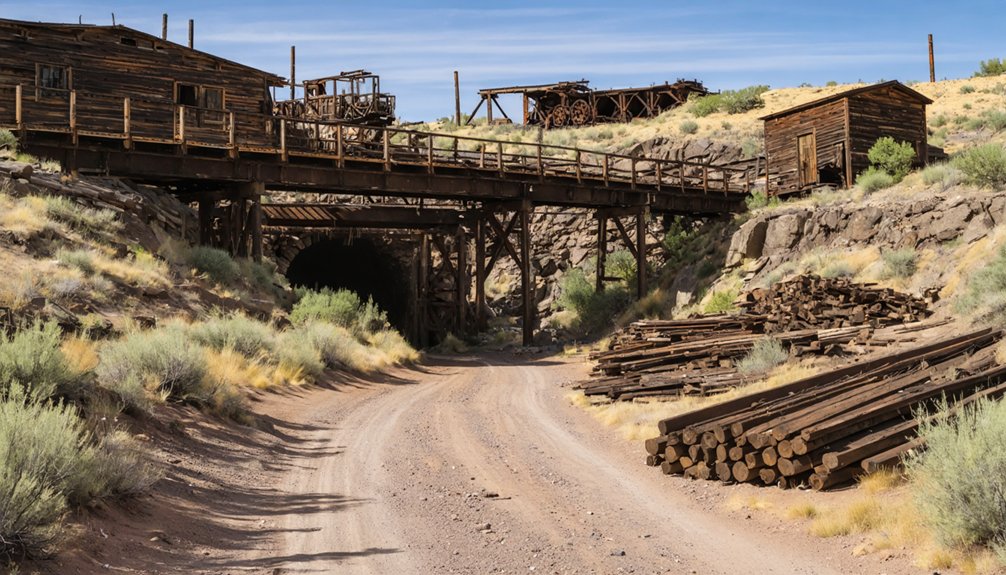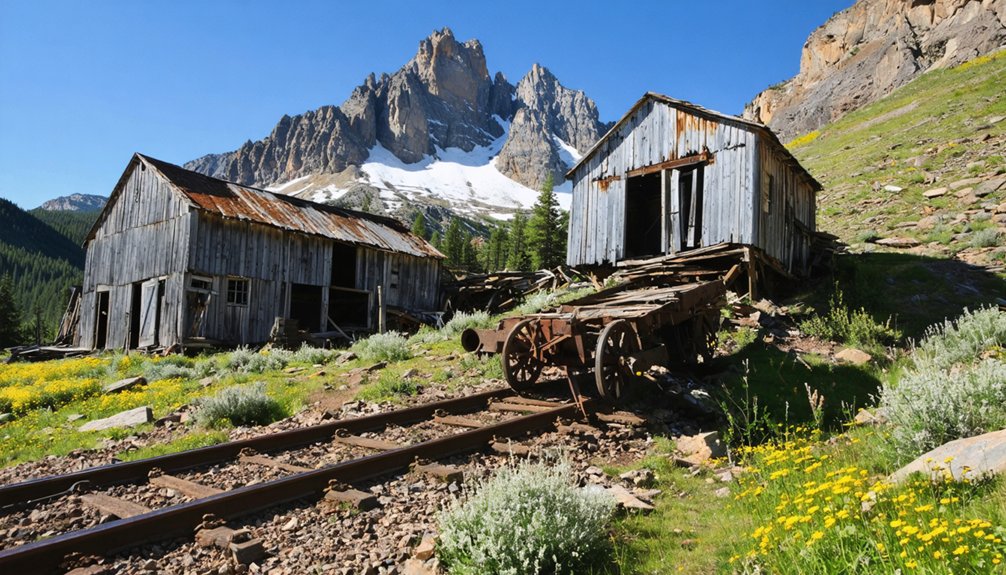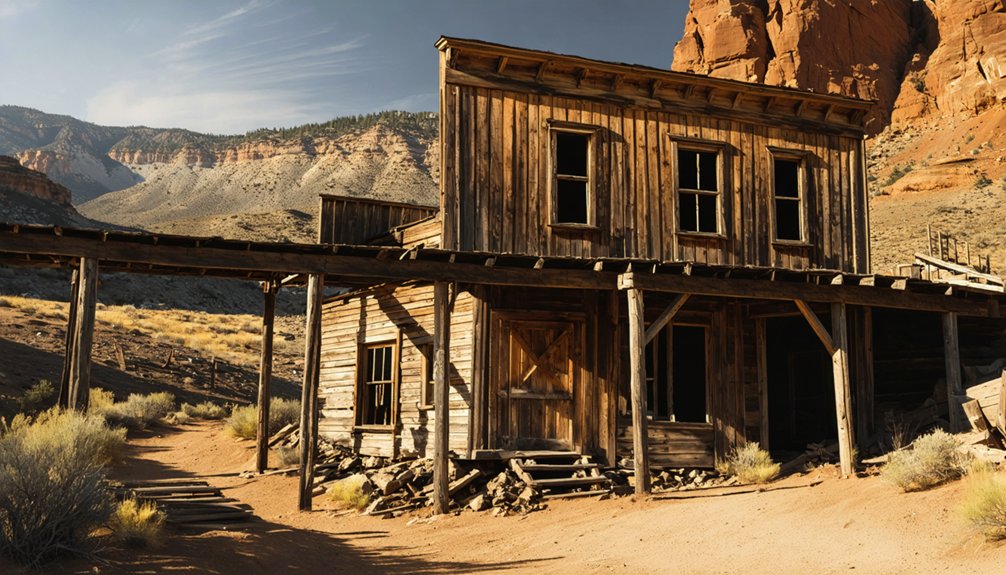You’ll find Cliff City nestled in Idaho’s White Knob Mountains, where copper’s discovery in 1879 sparked a mining boom that lasted until the early 1900s. The town grew to include a 50-ton smelter, stores, saloons, and a Methodist church, with mineral production reaching $3.75 million by 1914. Today, you can explore this ghost town‘s mining heritage through Mackay’s Mine Hill driving tour, featuring 13 interpretive stops across 24 miles. The ruins hold countless untold stories of Idaho’s copper mining era.
Key Takeaways
- Cliff City emerged in 1879 after copper discovery in Idaho’s White Knob Mountains, becoming a bustling mining town with essential services.
- The town featured a 50-ton smelter, stores, saloons, post office, and Methodist church during its peak copper production years.
- Total mineral production reached $3,750,000 by 1914, with the Copper Cliff Mine contributing 25% of Idaho’s copper output.
- Transportation evolved from horse-drawn wagons to include Shay railroad and aerial tramway systems for ore transport.
- Visitors can explore the ghost town’s mining ruins via Mackay’s Mine Hill driving tour, featuring 13 interpretive stops.
The Birth of a Mining Frontier Town
When copper was discovered in Idaho’s White Knob Mountains in 1879, it sparked the birth of Cliff City and neighboring settlements that would shape the region’s mining frontier.
You’ll find that Cliff City emerged as one of the earliest mining settlements, strategically positioned near the southern end of the Empire Mine where a 50-ton smelter processed valuable copper ore. The town’s infrastructure quickly expanded to serve the growing mining community, offering you a glimpse of frontier life with its stores, saloons, post office, schools, and theater.
While initial mining activity focused on lead-silver deposits in the nearby Nicholia district, it was the copper discoveries that truly defined Cliff City’s character. The total mineral production from the area reached an impressive $3,750,000 by 1914.
The settlement’s 30-ton-per-day smelter operations in 1890 marked the beginning of serious mineral extraction in the area.
Life in the Copper Boom Years
During Cliff City’s copper boom years, you’d find a bustling mining camp equipped with essential services including a store, twenty houses, four saloons, and a Methodist church supporting hundreds of workers.
The daily rhythm centered around the 50-ton smelter processing ore with 4% copper content, while miners worked shifting schedules that adapted to market conditions.
Your typical day might involve interacting with the town’s diverse population of miners, smelter workers, and service providers who kept the community’s economic engine running through the boarding house, blacksmith shop, and livery stables.
Daily Mining Camp Life
Life in Cliff City’s copper mining camp revolved around basic necessities and harsh working conditions that defined the boom years. You’d find yourself living in hastily built wooden structures, either in small family homes or boarding houses if you were a transient worker.
Mining conditions were grueling, with demanding schedules at the open-pit mines and smelters where about 500 men labored.
Your daily routine would’ve centered around the town’s essential services – four saloons, stores, blacksmith shops, and the Methodist church.
Community interactions flourished despite the hardships, with social gatherings at restaurants and community celebrations fostering camaraderie.
The 50-ton smelter’s operations and electric railways kept the town’s economy moving, though you’d face constant uncertainty from copper price fluctuations and occasional mine closures.
Supporting the Copper Economy
The copper boom years of Cliff City have shaped Idaho’s mining legacy through sophisticated economic and infrastructural developments.
You’d find evidence of this in the region’s robust copper production system, which included a 600-ton smelter and a twelve-mile electric railway at nearby Mackay to handle the massive ore transportation needs.
As you explore the area’s economic impact, you’ll discover how Copper Cliff Mine contributed about 25% of Idaho’s copper output in 1976, processing 150,000 tons of ore through its flotation mill.
The operation’s success relied on extensive infrastructure networks, including aerial tramways and rail connections established in 1901.
These developments transformed Cliff City into a thriving hub, complete with stores, boarding houses, and other essential facilities that supported hundreds of mining workers.
Industrial Heritage and Mining Operations
Mining operations transformed Cliff City, Idaho into a significant industrial hub during the late 19th century, centered primarily around substantial copper deposits in the Copper Basin region.
The town’s industrial heritage showcases remarkable mining technology advancements that you can still trace through surviving infrastructure and historical records.
Key technological developments that shaped Cliff City’s mining operations include:
- A fifty-ton smelter that operated from late 1890 to February 1891, processing complex ores from White Knob’s primary lode.
- Twelve-mile electric railways and aerial tramways that revolutionized ore transportation across challenging terrain.
- A 100-ton concentrating mill erected in 1911, marking significant progress in ore processing efficiency.
Despite initial financial struggles and mismanagement, these innovations helped establish Cliff City’s prominent role in Idaho’s mining industry, contributing to regional production values exceeding $3,750,000 by 1914.
Daily Life and Social Scene
During its brief heyday, Cliff City‘s social fabric revolved around a tight-knit community of three hundred miners who populated roughly twenty houses scattered across the rugged terrain.
You’d find the community dynamics centered around two or three saloons, where miners gathered after long shifts to unwind and share stories. The local store served as another hub for social interaction, where you could catch up on news while purchasing essential supplies. The Big Copper mine provided the foundation for the town’s existence and daily routines.
Tired miners found refuge in Cliff City’s saloons and store, sharing tales and news while building lasting community bonds.
Like many communities along the Mine Hill Tour, visitors today can still explore remnants of this once-bustling settlement. Though records don’t detail specific social gatherings, you can imagine the typical mining town activities – celebrations after successful operations, informal meetings at the saloons, and the daily exchanges between neighbors living in close proximity.
Despite the harsh conditions and isolation, these venues created spaces where miners could forge bonds and maintain a sense of community.
Transportation Networks and Infrastructure

You’d find a fascinating evolution of transport systems around Cliff City, from early horse-drawn wagons on dirt roads to the more sophisticated Shay railroad that operated from 1905.
The mining railroad was later superseded by a six-mile aerial tramway system in 1918, featuring 36 wooden towers that carried ore buckets along steel cables to the smelters below.
The network of mountain roads connected Cliff City to neighboring settlements like Houston, just four miles away, enabling essential movement of mail, supplies, and workers throughout the mining district.
The local infrastructure included stores and saloons that served the bustling mining community during its peak years.
Rail and Tram Systems
The evolution of Cliff City’s transportation systems reflects an intriguing shift from early rail networks to advanced aerial solutions.
You’ll discover how railroad evolution shaped mining operations, starting with the 1905 Shay system that served as the lifeline for ore transport.
When 1918 arrived, innovative tramway technology revolutionized the area’s logistics.
Here’s what made the transformation remarkable:
- A six-mile steel cable loop supported by expertly crafted wooden towers replaced traditional rail lines
- The gravity-powered system slashed operational costs while boosting reliability
- The aerial tramway’s headhouse still stands as a testament to engineering ingenuity
The preservation of these historic transportation networks offers you a glimpse into the innovative spirit that drove Cliff City’s mining success, with remnants now serving as enchanting heritage sites.
Mountain Road Networks
While rail systems defined Cliff City’s industrial growth, mountain roads formed the crucial arteries that sustained its daily operations.
You’ll find these mountain access routes carved through challenging terrain, connecting Cliff City’s copper smelter to Houston just four miles away. The road construction faced typical Idaho challenges – steep grades, rocky soil, and harsh weather – but proved essential for moving workers, ore, and supplies.
Early builders used graded dirt, gravel, and local timber to establish these crucial links, evolving from basic trails to wagon roads. Modern digital collections access now allows researchers to study detailed maps and photographs of these historic transportation networks.
You can trace how this network supported not just the smelter operations, but also the movement of timber from Alder City’s sawmills and the transport of necessary provisions.
These mountain thoroughfares created a lifeline between mining camps, enabling Cliff City’s brief but significant industrial prominence.
The Rise and Fall of Neighboring Settlements
During Idaho’s copper mining boom of 1879-1880, several settlements sprang up around the White Knob Mountains as prospectors discovered rich mineral deposits in the region.
Mining techniques evolved rapidly as companies invested millions in infrastructure, though economic fluctuations made success elusive for early operators. Wayne Darlington discovered copper in 1901, leading to new development in the area. The area gained significant investment from John W. Mackay, a prominent Nevada mining engineer who funded local operations.
You’ll find three key developments that shaped these neighboring settlements:
- White Knob town emerged on “Mine Hill” with crude dwellings and mining facilities.
- Cliff City established essential services including stores, saloons, and a theater.
- The Oregon Short Line Railroad’s arrival in 1901 connected these communities to larger markets.
Despite initial prosperity, these settlements couldn’t sustain themselves.
When Empire Copper Company took over, they shifted to a leasing model, but earlier mismanagement had already set decline in motion.
Legacy in the White Knob Mountains

Located within Idaho’s rugged White Knob Mountains, Cliff City’s legacy weaves together diverse cultural threads spanning thousands of years.
You’ll find the area’s Indigenous Heritage deeply rooted in Shoshone-Bannock traditions, with archaeological evidence revealing over 8,000 years of native presence before mining transformed the landscape. The mountains’ exposed granite plutons create dramatic near-vertical towers that served as natural landmarks. These towers reach impressive heights of 700 feet above the surrounding terrain.
The region’s Cultural Significance evolved through waves of change – from early fur traders to copper miners, and importantly, Basque immigrants who brought their distinctive customs to the area.
While the mines that built Cliff City have long since closed, you can still trace their impact in the surviving infrastructure, including the historic Mackay Dam.
Today, the descendants of the Shoshone-Bannock at Fort Hall Reservation and the local Basque community continue to influence the cultural tapestry of this mountain landscape.
Exploring the Ghost Town Today
Today’s visitors to Cliff City can explore this historic mining site through the extensive Mackay’s Mine Hill driving tour, which connects a network of 13 interpretive stops across 24 miles of mountain terrain.
Discover Idaho’s mining past along Mackay’s Mine Hill, where 13 historic stops wind through rugged mountain landscapes.
This ghost town exploration reveals the historical significance of Idaho’s mining heritage through weathered ruins and scattered remnants of the once-bustling copper smelting operation. Similar to pioneer life at Chesterfield, survival in these remote mining areas required remarkable resilience.
When planning your visit, remember these essential points:
- Choose your route based on vehicle capability – options exist for ATVs, high-clearance vehicles, or standard passenger cars
- Pack all necessary supplies, as there are no facilities or services in this remote location
- Study interpretive panels at each stop to understand the original functions of building foundations, smelter remains, and mining equipment
Frequently Asked Questions
Were Any Significant Crimes or Shootouts Reported in Cliff City’s History?
You won’t find documented crime stories or shootout incidents in historical records. While the mining town had saloons and miners, there’s no evidence of significant violent episodes or criminal events.
What Happened to the Original Residents After the Town Was Abandoned?
Like scattered seeds seeking fertile ground, you’d find most residents planted new roots in Houston and Mackay’s thriving mining towns, while others dispersed across Idaho chasing fresh opportunities and stable work.
Did Any Famous Outlaws or Notable Historical Figures Visit Cliff City?
You won’t find any famous outlaws or notable historical visitors documented at Cliff City. Despite mining town legends, historical records show only typical miners, laborers and company officials frequented the area.
What Was the Average Wage for Miners Working in Cliff City?
Like striking copper veins, you’d earn about $3 to $3.50 per day as a general miner, while skilled workers and engineers could pocket around $4 daily in the historical economy of the mines.
Were There Any Documented Natural Disasters That Affected the Town?
You won’t find documented evidence of major natural disasters. Historical records don’t show significant earthquake impacts or flood history during the town’s existence, though early record-keeping was often incomplete.
References
- https://history.idaho.gov/wp-content/uploads/0208.pdf
- https://www.ghosttowns.com/states/id/cliffcity.html
- https://www.rvtravel.com/ghost-town-trails-mackays-mine-hill-rvt-1054/
- https://history.idaho.gov/wp-content/uploads/2018/08/0009.pdf
- https://westernmininghistory.com/towns/idaho/mackay/
- https://www.youtube.com/watch?v=rTSZSlxTmbs
- https://www.achp.gov/preserve-america/community/mackay-idaho
- https://www.idahogeology.org/pub/Staff_Reports/1997/S-97-2.pdf
- https://www.hmdb.org/m.asp?m=140071
- https://www.idahogeology.org/pub/Staff_Reports/1997/S-97-4.pdf



